(Minghui.org) Some people consider evolution a fact and some treat it as a theory. The discussion can be more intriguing when it comes to viruses, especially COVID.
Dilemma of Evolution
Charles Darwin once used the giraffe to explain his theory of evolution – longer-necked giraffes were more likely to survive a drought as they were better able to reach leaves on taller trees than their shorter-necked peers. But such a hypothesis is rejected even by mainstream Darwinists today. For example, i) a taller giraffe with a longer neck is also heavier than others, making them less likely to survive in a drought. ii) Male giraffes are much taller than females, newborns, or younger peers. According to Darwin’s theory, the latter would have died and the species would have become extinct. iii) Many animals without long necks could also reach higher food. For instance, goats can climb into trees and eat leaves.
Another example that cast doubt on evolution is insect wings, which can beat 200–1000 times per second. Aside from being thin, light, and fine, the wings are rich in muscle groups with an advanced nervous system. Furthermore, their aerodynamic feature such as flexibility helps positioning and navigation, which is more superior to flying objects made by humans. Not only that, the transition from primitive insects like silverfish in Early Devonian (400 million years ago) to Carboniferous Period (350 to 300 million years ago) was a relatively short time and the wings hardly changed since then, which contradicts the evolution theory.
The evolution theory has many loopholes and Darwin was unsure when he brought it up. For example, he could not explain the origin of flowering plants and even dubbed the plants a “disgusting mystery.” Similarly, he had difficulty understanding how eyes came into existence. “To suppose that the eye, with all its inimitable contrivances for adjusting the focus to different distances, for admitting different amounts of light, and for the correction of spherical and chromatic aberration, could have been formed by natural selection, seems, I confess, absurd in the highest degree,” Darwin wrote in The Origin of Species.
Are Viruses Alive?
Is virus a life form? This is a question that has been debated for a long time. In 1935, American biochemist Wendell M. Stanley extracted the tobacco mosaic virus in the form of pure crystals. Further research showed the virus is composed of protein and RNA. Most biologists consider the viruses not alive since they do not have metabolism, and their DNA or RNA cannot replicate without a host cell.
But viruses are also similar to many life forms in a variety of ways, including sharing the same building blocks. And they replicate and evolve too. Some bacteria can replicate only in other cells. All life forms that mankind knows rely on other living organisms. As a result, there is no clear dividing line between viruses and other life forms.
Furthermore, some giant viruses have been discovered recently and their sizes are similar to that of bacteria and they also have metabolic genes. In fact, researchers from University of California San Diego found bacteriophage (one type of virus) could form nucleus-like compartments to protect its replicating genomes by excluding host defense factors. This work was published in an August 2022 Nature article titled “Architecture and self-assembly of the jumbo bacteriophage nuclear shell.”
Unexplainable Mutations
Biologists believe evolution progresses towards higher organisms through gene mutation. But such a claim can hardly apply to viruses. “The evolutionary history of viruses represents a fascinating, albeit murky, topic for virologists and cell biologists. Because of the great diversity among viruses, biologists have struggled with how to classify these entities and how to relate them to the conventional tree of life,” wrote a 2010 Nature Education article titled “The Origins of Viruses.”
“They may represent genetic elements that gained the ability to move between cells. They may represent previously free-living organisms that became parasites. They may be the precursors of life as we know it,” the article continued.
The larger population a species is, the shorter time it would take to produce mutations, wrote American biochemist Michael Behe in The Edge of Evolution. Bacteria, for example, are more likely to undergo mutation than primates.
One example is Plasmodium falciparum, the parasite that caused malaria. There are about one trillion (1012) malaria cells in a sick person, or 100 million times more (1020) P. falciparum parasites in the world. Yet, it took dozens of years to produce a mutant with two amino acid changes that is resistant to chloroquine. Because the number of human beings is much smaller, Behe believed it would take 1,000 trillion (or 1015) years for humans to acquire such a mutation. Since it requires 147 amino acid changes from primate to human, such an “evolution” is impossible.
Viruses such as HIV, on the other hand, do have quick mutations, but they add little to the functional changes. “Viruses contain much less genetic material, but it mutates so rapidly, and there are so many copies of it, that HIV alone, in just the past fifty years, has undergone more of at least some kinds of mutations that all cells have experienced since the beginning of the world,” wrote Behe.
Additional studies showed “each and every possible single-point mutation occurs between 104 and 105 times per day in an HIV-infected individual.” Nonetheless, these mutations made little change on the evolution of HIV. “There have been no significant basic biochemical changes in the virus at all.”
The Origins of Viruses
There are also some interesting discussions about evolution. If “survival of the fittest” is really true, then the plants would become inedible or toxic, so that they would not be consumed by animals or humans. Some evolutionists argued it did not become this way because human beings had selectively grown the tasty ones. “That confirms that it is never natural selection, but intervention by higher beings,” one netizen wrote.
Isaac Newton had a friend named Edmond Halley. As an atheistic physicist, Halley believed the universe “just happened.” Once Newton made a sophisticated solar model. When one cranked the model, planets would move in their own orbits. When Halley came to visit and saw the model, he was amazed and asked who made it.
“Nobody,” replied Newton.
Halley was very upset and said, “You must think I'm a fool! Of course somebody made this! He’s a genius, and I’d like to meet him!”
Newton said the model was just a poor imitation of our wonderful universe. “You know the laws and the precise order that governs our universe. I can’t seem to convince you that this model, this toy, does not have a designer or a maker,” he continued. “However, you have said many times that the solar system, which this model represents, ‘just happened.’ Now tell me, is that the logical conclusion of a scientist?”
Similarly, the origins of viruses are also a mystery for evolution. Due to the diversity of viruses, scientists do not believe they have a single common ancestor. Viruses are everywhere. “For instance, if all the 1 × 1031 viruses on earth were laid end to end, they would stretch for 100 million light years,” wrote a 2011 Nature Reviews Microbiology article titled “Microbiology by numbers”.
“Furthermore, there are 100 million times as many bacteria in the oceans (13 × 1028) as there are stars in the known universe,” the article continued. “The rate of viral infection in the oceans stands at 1 × 1023 infections per second, and these infections remove 20–40% of all bacterial cells each day.”
Human beings, on the other hand, seem very powerless. Scientists believe mankind has only successfully eradicated two infectious diseases caused by viruses, smallpox for humans and rinderpest for cattle. Throughout history, however, viruses have ravaged the earth countless times, from ancient Greece to ancient Rome to the Spanish flu 100 years ago. Even modern society with advanced technology seems quite powerless in the face of COVID.
A Time for Reflection
Ancient people cherished virtue and believed that when mankind acted at will and went against the heavenly principles, they would be in danger and be hit with floods, earthquakes, diseases, or other catastrophes.
Many people believe the plagues that ravaged the ancient Roman Empire were consequences of its persecution of Christians. Black Death was often viewed as the scourge of God. Spanish flu also broke out when communism occupied Russia, while the COVID pandemic seems to target the Chinese Communist Party.
“Truth be told, pandemics only come when people’s morals and values have turned bad and they have come to have a massive amount of karma,” wrote Mr. Li Hongzhi, founder of Falun Dafa, in “Stay Rational.”
Mr. Li continued, “So if a pandemic is divinely ordained, what can be done to stop it? It would be divine will, after all. Some people do realize this and pray for protection, but it probably won’t help. That is because people are supposed to be weeded out when their moral character has turned bad and their karma has become huge. Why would the divine offer them protection at that point, then? What people should do, instead, is to repent to the divine with all due sincerity, admit to their faults, and pray for a chance to change their ways. That is the way to go, and that is the magic cure.”
“... a pandemic like the current Chinese Communist Virus (or “Wuhan Virus”) comes with a purpose behind it, and it has targets. It is here to weed out members of the Party and those who have sided with it,” wrote Mr. Li in the same article and advised: “People should distance themselves from the CCP and stop siding with the Party. Behind it is the red Devil, while outwardly it looks and acts like a thug who stops at no evil. So now that the divine is starting to eradicate it, all who still stand by it shall perish.”
Views expressed in this article represent the author's own opinions or understandings. All content published on this website are copyrighted by Minghui.org. Minghui will produce compilations of its online content regularly and on special occasions.
Category: Perspective










